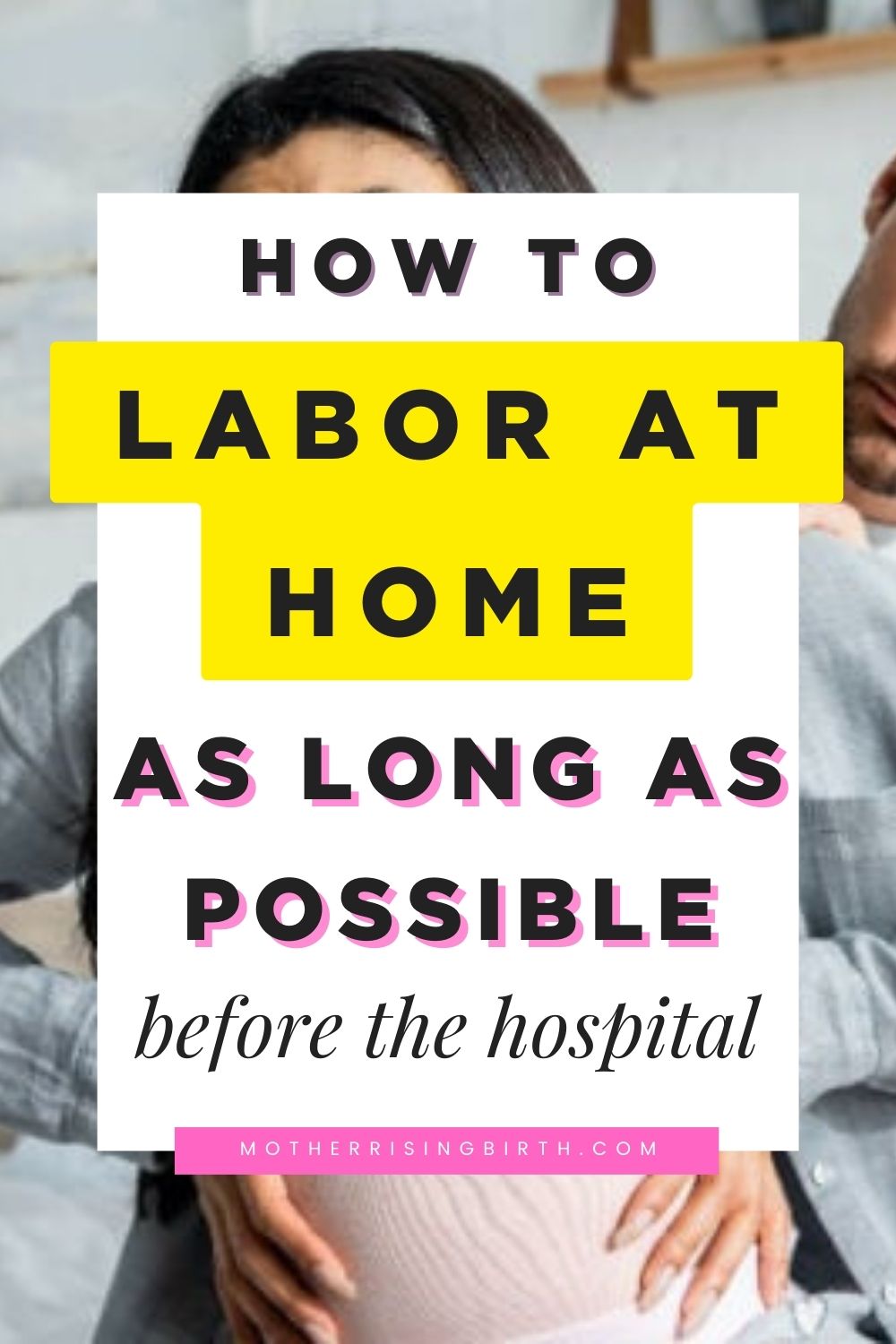Many women in my childbirth classes and those that hire me for doula support often ask for tips on how to labor at home as long as possible. In fact, one of the big reasons they may hire a doula or take a childbirth class is to facilitate laboring at home for the majority of their labor, and arriving at the hospital for transition and pushing.

On This Page
13 minute read
↓Why Labor at Home?
↓Time Out!
↓Tips to Arrive During Transition
↓Notice the Timing of Contractions
↓411 Contraction Rule
↓Notice These 3 Things
↓Try to Stop or Slow Labor
↓Signs of Transition
↓You’ll Just Know
↓No Car Baby, Please!
↓Want More?
Why Labor at Home?
Before we get into the nitty gritty on how to labor at home as long as possible, let’s discuss why laboring at home is an option many pregnant women desire.
1. Encourage Oxytocin
One reason some women labor at home as long as possible is to keep their labor as straightforward, smooth and short as possible. Hormonally speaking, the further a woman is in her birth experience, the harder it is to disrupt the flow of oxytocin (the hormone which causes contractions) and therefore her labor pattern.
According to the hormonal blueprint of labor, if a woman heads to the hospital as soon as signs of labor begin, in early or even sometimes in active labor, things might fizzle out. Her contractions will stop and she’ll be sent home, frustrated and exhausted. Not cool!
However, if a woman experiences long, hard contractions that are close together before going to the hospital, odds are that the act of leaving home, getting into the car, and showing up at the hospital won’t affect her labor or disrupt the release of oxytocin.
2. Less Pitocin
In my experience, women who labor at home for the majority of their birth experience and “show up at the hospital to push a baby out” are WAY less likely to need pitocin to augment or strengthen their labor.
Frankly, the labors of the women who do most of their work at home in a serene birth environment, are strong and impossible to stop! By laboring at home and getting into a good labor pattern before going to the hospital, pitocin is less likely a possibility.
3. Unmedicated Birth
Women wanting to labor at home as long as possible are planning for an unmedicated birth. And in my experience, women who labor at home as long as possible are WAY less likely to need IV pain meds (narcotics) or an epidural to get them through the rest of their labor. Often, there’s just no time to get an epidural because things are moving quickly once she arrives.
Other times, she’s learned to cope through her contractions while at home and continues coping just as well even when admitted to the hospital. She’s got this!

4. Pain Coping
Many women that labor at home as long as possible do so because it is easier for them to cope through their labor pains in the comfort of their own homes. These women were more comfortable and less fearful at home and therefore better able to cope through their intense contractions. Natural birth can be less painful by following some basic tips!
5. Planning a VBAC
Another reason to labor at home as long as possible before heading to the hospital is when planning a VBAC (vaginal birth after cesarean). This may seem like odd advice, however, even my local hospital midwives tell their patients that “their best bet for a successful VBAC is to show up at 39 weeks ready to push”.
VBAC patients are monitored more closely and therefore have more opportunity for interventions, which unfortunately increases the possibility of other complications (this is called the cascade of interventions). For example, many care providers require constant internal fetal monitoring during a VBAC. Sounds reasonable, right?
Well… with constant internal fetal monitoring comes breaking the water (amniotic sac) and laboring in bed. By doing these two interventions the risk of infection has increased and also the need for an epidural (because her range of pain coping has decreased by limiting her movement).
Therefore, under the careful guidance of a trusted care provider, laboring at home as long as possible may be a key component to achieving a VBAC.

Time Out!
… which leads me to my next point. It’s ok to go to the hospital! If you need to go to the hospital, you should go. If something isn’t right, you should go. It’s ok to utilize your support team and care provider. If you need medical advice, call your care provider or a nurse.
If you are laboring at home as long as possible because you are fearful – of the hospital and/or staff – you are laboring at home for the wrong reasons. Making decisions based on love – for yourself and your baby – instead of fear, is the way to go. Birth without fear!
If you don’t feel safe, comfortable or trust your care provider or hospital, choose a new one! It’s never too late to fire your OB!
(I know someone that switched care providers… DURING LABOR! Be brave and do what you gotta do to get things done safely and effectively.)
If you need to brush up on how to talk with your care provider and make decisions check out this post about the brain acronym!
Tips to Arrive to the Hospital During Transition
If you are hoping to labor at home as long as possible before heading to the hospital, odds are your goal is to arrive at the hospital at the end of the first stage of labor while in transition, or right before transition. The following are tips on how to do just that. Good luck!
1. Take a Good Childbirth Class
The foundation to laboring at home as long as possible is quality childbirth education. If a laboring mom is ignorant of her body, pain coping, the labor process, etc., how in the world is she going to navigate labor at home?
After completing a good childbirth class series you should have a solid understanding of how labor progresses, pain management for labor, and birthing tool options.
2. Hire a Doula
The next layer to successfully laboring at home is to hire a doula. A doula has witnessed many labors and is an invaluable asset when determining when to head to the hospital.
If I have a doula client that is unsure about whether to go to the hospital or not sometimes I’ll just head on over to their home to check things out myself. FaceTime works too! Usually in less than 5 minutes I will know if it’s time to go or not. A doula is so helpful in this situation!
3. Be Ready to Go
as long as possible is to be 100% ready to go at a moment’s notice. When laboring at home, parents should not be packing a hospital bag, it should already be done. Phone chargers, wallets, pillows, a towel to sit on, etc., should be in the car ready to go while mom is laboring inside at home.
If the decision to go to the hospital is made, everyone should be able to get in the car and go in just a couple of minutes.

4. Notice the Timing of Contractions
An extremely effective tool to help determine when to go to the hospital is timing contractions. If you are unsure on how to time contractions, you can download an app! There are so many of them, and most are free.
Time Between Contractions
The first thing you need to look for is how far apart the contractions are. Contractions are measured from the start of one to the start of the next. Some parents wanting to labor at home as long as possible may go when their contractions are around 3-4 minutes apart.
Length of Contractions
Another way to know when to go is to notice how long each contraction is lasting. In early labor, contractions average around 30 seconds. During active labor, they increase in length to around a minute. During transition, they may be even longer at 90 seconds.
When your contractions are around 4 minutes apart and lasting 60 seconds or longer it might be time to head in to the hospital.
Duration of Contractions
One last aspect of contractions to consider when laboring at home is how long a particular series of contractions has been taking place. If you have been having contractions 3 minutes apart, each one lasting a minute, but this has only been going on for 20 minutes, you might need to time a few more contractions to make sure this is the real deal.
When in doubt, see if this pattern continues for an hour. If things are progressing, remaining intense, and not going away for the last hour, you might want to head to the hospital!
4-1-1 Contraction Rule
To put it all together, I suggest remembering the 4-1-1 contraction rule. When your contractions are 4 minutes apart, lasting for at least 1 minute, and this has been going on for 1 hour – you might want to go to the hospital.
Even then, there are more things to take into consideration when the goal is to labor at home as long as possible.

5. Notice These 3 Things
1. Notice Mom’s Mood – Between Contractions
Sometimes, even when contractions are a solid 4 minutes apart, it’s might not time to head into the hospital. One way to know what to do is to observe mom’s mood BETWEEN contractions.
Normally, during a solid active labor contraction a mom works hard at coping, breathing, etc., but between contractions she’s in a good mood, talkative and generally her normal self. However, when a laboring mom’s mood BETWEEN contractions changes, that’s when I start paying attention.
Here are some things to look for BETWEEN contractions that might signal it’s time to take the drive to the hospital:
- She closes her eyes and goes within, even when not having a contraction.
- Stops chatting with family, friends or the birth team even between contractions.
- Annoyed at the chatter of birth companions, even between contractions.
- Becomes irritable, agitated and easily annoyed even when experiencing a break between contractions.
If her contractions are close together AND her mood between contractions has shifted, it’s probably time to go to the hospital.

(If you look as pleasant as the woman above on the couch, it’s not time to go to the hospital. 😉 )
2. Pay Attention to Mom’s Pace
Another thing to notice when determining when to go to the hospital is how fast or slow the laboring mom is moving. In my experience, as a woman progresses through labor she moves increasingly slower.
I remember arriving at a doula client’s home to help determine if it was time to head to the hospital or not. My client was in the tub, laboring through her contractions. At one point she got out of the tub to head on over to her bed. It took her forever to get to her bed! I quickly realized that she was progressing and suggested heading to the hospital.
Just as I anticipated, it took her awhile to get dressed, downstairs and into the car. Thankfully, she made it to the hospital with perfect timing and wouldn’t you know it? She arrived in transition and soon pushed out her baby. Nailed it!

3. Notice When Mom Powers Off and Checks Out
If you are in labor but are able to continue texting and staying connected via social media, it’s probably not time to head to the hospital.
As lame as it sounds, at my births… especially my homebirth, I had considered posting updates on social media via my phone. However, once things picked up and got intense, I honestly did not have the ability and/or brain power to stay connected. My phone was abandoned and I focused on my one task – have a baby!
If you’re able to stay connected via your phone, it might not be time to head to the hospital.

Try to Stop or Slow Labor
If you’re still unsure of when to go to the hospital, try to see if you can slow or stop your labor. If you can slow things down, you definitely should stay home.
Ways to Slow Labor
- Drink a glass of water
- Take a bath
- Take a shower
- Lie down for a nap
- Go to bed for the night
- Take a walk
If after trying the above activities labor has slowed or stopped, that can it’s probably not time to go to the hospital. However, if you find labor remaining the same or becoming even stronger, it might be time to head to the hospital.

Signs of Transition
Here is a list of symptoms or signs of transition. If you are experiencing these things, coupled with the signs listed above, it’s definitely time to go.
(For help coping through transition without an epidural read this.)
- Long contractions lasting around 90 seconds (in comparison, the average active stage contraction is around 60 seconds)
- Contractions become longer, stronger, and closer together – around 2-3 minutes apart
- Instead of completely going away contractions sometimes “double peak”
- Because of all this ^ it feels like you’re not getting a break. You may hear yourself say, “I’m not getting a break.”
- Hot and sweaty
- Cold and shaky
- Nausea
- Vomiting
- Crying
- Can’t find a comfortable position
- Contractions increase when changing positions
- Afraid to change positions
- Looking for a way out
- Water breaking
- Discouragement and/or giving up
- Irrational thoughts and behavior
- Asking for pain medication

“You’ll Just Know”
A few times in my doula career I have received a phone call to go over to my client’s home in order to help determine whether or not it was time to go to the hospital. While on my way there, I received yet another call saying that they decided to go in because it became obvious that it was time to go. They “just knew”.
Sometimes, you just know. If you have a gut feeling that it’s time to go to the hospital, then listen to that voice! Go make like a baby and head out! (lol lol lol)

No Car Baby, Please!
Of course, this article wouldn’t be complete if I also explain how to get to the hospital without having a car baby. This is an important topic, especially for those that live out of town. Nobody wants to have a car baby! Use the link in this paragraph to learn more.
Want More?
For more juicy articles about rocking the hard parts of birth, try the how to’s below.


Elizabeth
Friday 19th of August 2022
Been having painful contractions for weeks. Came to the hospital with contractions 3-4 minutes apart, over a minute long, and they were super intense, and torture to walk through. Got here, no change and the nurse was frustrated with me. Plus the contractions quit as soon as I sat on the bed to be monitored! They weren't quitting at home or when I walked in.
Jenna
Friday 15th of April 2022
I printed this article and followed it! Was able to successfully labor at home and arrived at the hospital during transition and went on to deliver my baby unmedicated! Thank you!
Lindsey VanAlstyne
Saturday 16th of April 2022
This is awesome. Thank you for letting me know!
Cynthia Paradise
Friday 30th of July 2021
I live how informative this article is I'm currently 23 weeks and I'm planning to labor at home. There aren't many doulas close to my area so I'm not sure that is a option for me but all of these tips are so helpful.
Lindsey VanAlstyne
Friday 30th of July 2021
I'm so glad!
Katie
Tuesday 29th of September 2020
With all due respect, to tell women that they can fire their provider up until during the birth just stinks of privilege and victim blaming. Some of us are limited by things such as our health insurance, which dictates which hospital we can go to.(others are limited geographically because there only is one hospital in their county as well...) At the only hospital my insurance permitted me, I was told that no, I cannot have another doctor, it is whoever is on duty, and that's final. Yes I was told this during labor. Before labor I called up the insurance and was told if I went anywhere else the insurance would not pay. So to say to not delay going in if we're blessed with another baby due to fear is just wrong. Some of us have no other option! If you're going to tell tales of people doing what to many of us is the impossible, please Don't omit details - did this person's insurance pick up the bill? Do they have an ultra expensive plan that allows you to go anywhere? Are they tens of thousands of dollars in debt now? To claim that we can all have these privileges, when we can't is extremely hurtful.
Lindsey VanAlstyne
Thursday 1st of October 2020
A really good book that touches on this subject is Birth Without Fear. She gives so many of the details you are requesting. I highly recommend it!
Rachel
Sunday 19th of July 2020
I had such a terrible experience with my doula during my first pregnancy. The birth of my son went well and it all ended up okay, but I have such sadness remembering the impact our doula had on my husband and myself. Now that I'm pregnant again I am trying to work up the courage to look for a doula for the birth of my second child...but I'm scared! I think I have some birth-trauma from the experience! My goal is to labor at home as long as possible!